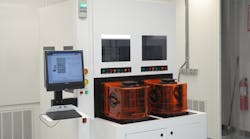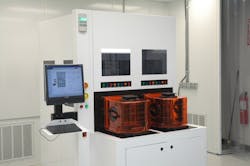Owens Design is located in Fremont, California, and makes high-speed material handling equipment for the semiconductor, disk drive, solar and consumer electronics industries. It often links machine control systems to higher-level IT systems, using a variety of different methods depending on the specific application.
This Owens Design 300 mm wafer platform is designed for semiconductor metrology equipment applications and is linked to IT systems via OPC.
Source: Owens Design
“Where the communications link is made from the HMI to an IT system, it’s typically through an OPC server running on the same PC as the HMI,” says Doug Putnam-Pite, director of software development, Owens Design. “The HMI’s OPC server connects to the machine or tool PLC, and the customer’s IT system connects to the OPC server running on our PC. With an OPC server running on the tool PC, several hosts can connect to the tool and gather data remotely,” adds Putnam-Pite.
Learn more with the main story: How to link machine controls to IT systems
“In the case where the machine or tool does not have a PC, then the customer will connect directly to the tool PLC using OPC. In these situations, the customer provides the OPC server and connectivity hardware,” explains Putnam-Pite.
Owens uses three major interfaces for these OPC connections: basic Ethernet, Ethernet using socket communication and EtherNet/IP. Ethernet using socket communication is typically used when the tool provided is a component in a larger tool.
“For OPC links via EtherNet/IP, the programming effort is typically fairly low. The primary task is documenting the interface so the customer knows the functionality of the tool variables and registers. This effort is one to two weeks depending on the size of the tool,” details Putnam-Pite.
“If we are providing an Ethernet socket communication interface, the effort level is much higher as our developers need to write the socket communication interface and often need to spend a significant amount of time working with the customer to integrate the tool into their system. This effort can be on the order of four to eight weeks,” notes Putnam-Pite.
“Communication standards in most automation environments are nonexistent, except for the semiconductor industry, and to a lesser degree the solar industry. Both these industries have widely adopted the SEMI SECS300 and GEM interfaces. The development and adoption of interface standards in other automation industries would help both machine and tool builders to integrate machines and tools to factory IT systems,” concludes Putnam-Pite.




